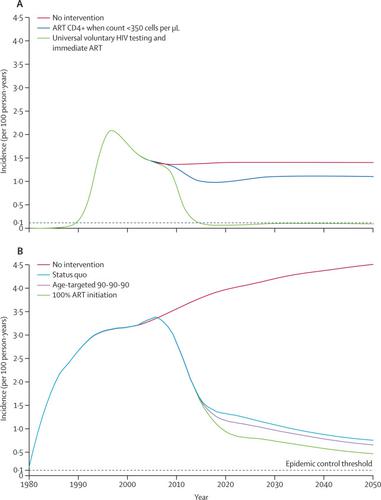当前位置:
X-MOL 学术
›
Lancet HIV
›
论文详情
Our official English website, www.x-mol.net, welcomes your feedback! (Note: you will need to create a separate account there.)
How universal does universal test and treat have to be?
The Lancet HIV ( IF 16.1 ) Pub Date : 2020-02-13 , DOI: 10.1016/s2352-3018(20)30031-x Rebecca F Baggaley 1 , T Déirdre Hollingsworth 2
The Lancet HIV ( IF 16.1 ) Pub Date : 2020-02-13 , DOI: 10.1016/s2352-3018(20)30031-x Rebecca F Baggaley 1 , T Déirdre Hollingsworth 2
Affiliation

|
HIV treatment as prevention, not only of HIV-related disease but also of transmission, was proposed in 2006 as a means to end the epidemic. Several influential studies and models predicted that early treatment of most people who live with HIV (PLWH) could reduce HIV transmission rates to near zero, at the population level., , As a result, treatment as prevention evolved into the universal HIV test-and-treat (UTT) approach, which entails offering HIV counselling and testing to an entire population and ART to all PLWH. In 2014, UNAIDS announced ambitious new goals to “end AIDS by 2030” by reaching 90-90-90 targets by 2020: 90% of PLWH knowing their status, 90% ART coverage among those knowing their status, and 90% viral suppression among people on ART.
中文翻译:

通用测试和治疗必须有多通用?
作为结束艾滋病流行的手段,2006年提出了将艾滋病毒治疗作为预防手段,不仅预防与艾滋病毒有关的疾病,而且预防传播。几项有影响力的研究和模型预测,对大多数艾滋病毒感染者(PLWH)进行早期治疗可以在人群水平上将艾滋病毒的传播率降低至接近零。, , 因此,治疗预防演变成普遍的HIV测试和治疗(UTT)的方式,这需要提供艾滋病咨询检测到整个人口和ART对所有艾滋病毒感染者。2014年,联合国艾滋病规划署宣布了雄心勃勃的新目标,即到2020年达到90-90-90的目标,“到2030年终结艾滋病”:90%的艾滋病毒/艾滋病感染者知道自己的状况,90%的ART覆盖率知道他们的状况,90%的病毒抑制人们在艺术上。
更新日期:2020-02-14
中文翻译:

通用测试和治疗必须有多通用?
作为结束艾滋病流行的手段,2006年提出了将艾滋病毒治疗作为预防手段,不仅预防与艾滋病毒有关的疾病,而且预防传播。几项有影响力的研究和模型预测,对大多数艾滋病毒感染者(PLWH)进行早期治疗可以在人群水平上将艾滋病毒的传播率降低至接近零。, , 因此,治疗预防演变成普遍的HIV测试和治疗(UTT)的方式,这需要提供艾滋病咨询检测到整个人口和ART对所有艾滋病毒感染者。2014年,联合国艾滋病规划署宣布了雄心勃勃的新目标,即到2020年达到90-90-90的目标,“到2030年终结艾滋病”:90%的艾滋病毒/艾滋病感染者知道自己的状况,90%的ART覆盖率知道他们的状况,90%的病毒抑制人们在艺术上。



























 京公网安备 11010802027423号
京公网安备 11010802027423号